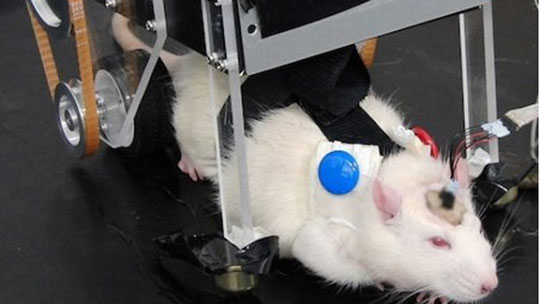It's a moving vehicle called Ratcar - a small car equipped with special parts, capable of signaling, appearing in the front hemisphere of the mouse when the vehicle moves. To read those signals, one attaches directly to the two-electrode mouse brain from the decoder box. The device also connects to an electric motor, instructing the " mouse car " to move.

Unique car of Japanese scientists. (Photo: Foxnews).
During the first training phase, the mouse was controlled by a power board with a switch to turn it on and off. They travel wherever they want, the decoder box reads the signals that appear on the hemisphere's large cortex. Thanks to this training, scientists can determine which decoder box needs to react to the next pulse.
After that, people fixed the mouse to the 'real' cars, so that their feet could come in contact with the floor comfortably. The freedom is limited, so the movement of the mouse can control the car, they just need to think where they want to go. The decoder box will objectively read and compare pulses, choose which pulses are recorded in memory and give commands to the electric motor. As a result, the mouse and the attached device can control the vehicle to move according to their wishes such as going forward, stopping, turning left, right, including backing up.
Six of the eight trained mice adapted to their new jobs, new lives, and even showed interest. People still don't understand how the mouse perceives it when it comes to moving directions. Maybe sitting in the car, the mouse does not think that he is going anywhere, straight or turning but simply knows' I go . to any place I like . that's all! '.
The scientists also found that high-sensitivity electrodes in the early stages can record a lot of ' strange ' nerve impulses that are unrelated to conscious movement. So it has to be ' filtered ' to get rid of those ' spam ' and this is what hinders scientists' research, which requires a great deal of effort to filter out the mouse brain signals to control the move.
The creators of the ' mouse car ' believe that this means of transport in the future will help people create wheelchairs for the disabled who have lost their ability to move limbs. But as any early medical invention must be carefully tested on laboratory animals. Choosing rats as test subjects is not random, because the structure of the brain and its activity are very similar between humans and mice.
Devices that help people with disabilities based on the principle of utilizing the ' neuron-machine ' interface are long-standing ideas. The person who mentioned this initiative since the 1960s is neuroscientist Paul Bach-i-Rita, but it takes a lot of time for the first machine based on this principle to be born.
In 2009, a group of American and Argentinian scientists returned to a paralyzed patient for the first time with the ability to connect to the outside world when connecting that patient's brain to a speech synthesizer and solution box. code, makes sounds sound meaningful. It was a young man at the age of 16 due to an accident that damaged the brain stem, causing him to be completely paralyzed (only able to move with his eyes), but still rational and cognitive.
When the patient was 21 years old, the researchers plugged an electrode into a large hemisphere shell, connected to a decoder box. After a while this disabled person can learn pronunciation, then accumulate words gradually. Now scientists are trying to perfect the decoding box, hoping in the near future will return to the patient the ability to pronounced a sound.
By creating the appropriate decoding boxes they also give blind people the ability to distinguish the colors and contours of moving objects. They are also working on devices that allow amputated people to use their thoughts to control their artificial limbs.
Until recently, in studies, the experimental animal was still a mouse. Most likely, when devices that help people with disabilities become popular and widely sold, people with disabilities will remember this kind of rodent with gratitude. They have helped them restore their mobility that has been stripped to become ordinary people.
 Daily use inventions come from universities
Daily use inventions come from universities Special weight loss device helps prevent appetite
Special weight loss device helps prevent appetite 8 inventors were killed by their own inventions
8 inventors were killed by their own inventions Iran invented a motor car powered by water
Iran invented a motor car powered by water